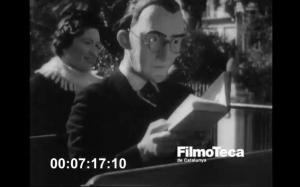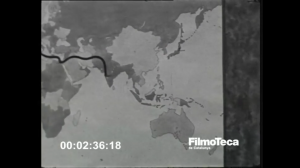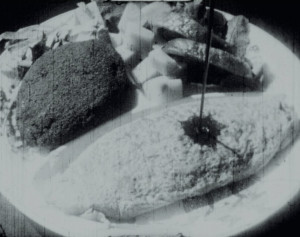"a soggetto"/fiction
"doc. a fantasia"/avant-garde documentary
"doc. scientifico"

(Catalan): Història d'un home que es creu important, que està carregat de prejudicis i que duu una màscara per mostrar una aparença de persona seriosa i culta. Però quan se la treu, en la intimitat, deixa de fingir i és feliç. Un dia, al tramvia, coneix una noia que l'ajuda a desprendre's de la màscara que porta gairebé sempre posada.
Story of a man who acts as if he is important and who wears a mask to show the appearance of a serious and cultured person. But when he takes it out, in the intimacy of the home, he stops pretending and is able to relax and be happy. One day, on the tram, he meets a girl who helps him get rid of the mask by cutting loose of all of his prejudices. [Description from the Filmoteca de Catalunya catalog]

(Catalan): Un explorador vestit de safari recorre el món fent escala a ciutats com Roma, El Caire, Bombai, Nova York i Tànger, fins al seu retorn a Barcelona. En el seu periple entra a un bar de Nova York, visita una barberia i veu com un pidolaire té una màquina registradora. A Camerún veu un mico, un senglar, beu aigua d'un coco, es topa amb un hipopòtam. A Tànger visita la ciutat i els seus habitants, entra a una mesquita i coincideix amb un grup de música i ball. Finalment, a la seva arribada a Barcelona és rebut amb els més grans honors.
Mockumentary that depicts a fictional trip around the world. An explorer travels the world, stopping in cities such as Rome, Cairo, Mumbai, New York and Tangier. During the journey we see him entering a bar in New York, visiting a barber shop and seeing how a beggar has a cash register. In Cameroon, he sees a monkey, a wild boar, and runs into a hippopotamus. He also drinks water from a coconut. In Tangier, he enters a mosque and meets a music and dance group. Finally, upon his arrival to Barcelona, he is received with the greatest honors. All the locations were recreated by the director.

This film symbolizes a city man with a triangle and a country woman with a circle to express their encounter through movements. This work was created by using the Kinemacolor technique. To create a multi-color film, the creators shot a black-and-white film, alternating frame by frame between a red filter and a green filter, and developed it. They colored the film alternately in red and in green frame by frame, and projected the completed film at twice the normal speed (28fps to 32fps, according to Ogino).
"The most stylistically experimental film among Kaneko’s works but also one of the most self-reflexive Japanese films of the interwar period. In this film, Kaneko featured the process of 9.5mm filmmaking by means of visual experiments and abstraction. By constructing the film in a way to trace the process of shooting, self-developing, editing, and projecting a film, he manipulated montage and multiple exposures as well as the use of light and shadow, while he elaborated the use of close-up shots that captured film devices and the filmmaker (presumably Kaneko himself) at work... Many advanced amateurs considered the process of filmmaking as an essential part of defining the idea of amateurishness. Unlike commercial productions that involved many casts and crews, amateur productions had the privilege of creating a work individually by going through the entire process of filmmaking, which allows the filmmaker to make every decision on his or her own. Kaneko’s Film Study 9 1/2 visualized this process by reflecting his artistic sensibilities." - Noriko Morisue, "Filming the Everyday: History, Theory, and Aesthetics of Amateur Cinema in Interwar and Wartime Japan" (Yale University: PhD Dissertation, 2020): 111.

"Just a few years after the commercial release of Pathé Baby equipment [Mori Kurenai] was already a master of his craft, using a variety of trick shots, special effects, stop-motion animation, colouring processes, dialectical montage... Kitchen Drama is a vivid, fast-paced, and delicate portrayal of female domestic labour." - Anna Briggs, Michele Manzolini and Mirco Santi, "The Making of 9 1/2," Journal of Film Preservation, 108 (April 2023): 73.
"Okamoto again demonstrates his fine sense of composition, repose and rhythm. Okamoto never hurries his pictures, neither does he hold them too long to bore you. He plans only to give you another fine picture, but he always puts life into his shots. Autumn Leaves is a fine Okamoto offering, but in the opinion of the judges it does not contain the same spark of creation as his last year's effort, 'Tender Friendship'." American Cinematographer, Jan. 1936, 24.
"In the countryside of Japan, the atmosphere of autumn is captured in shots of bare trees, reeds, reflections and sunlight on rippling water, floating leaves and dark clouds. A woman carrying a small child on her back is reflected in water as she stands near a pole, then rests against a harvest stack while crocheting from a ball of yarn. She walks along a path surrounded by farmed terraces. A child (described in the opening titles as motherless) plays with a paper ball while the grandfather tills the soil. The child blows into the ball to inflate it and the grandfather gets out his pipe and lights it with a match. Then he helps to inflate the ball. Against a sky of darkening clouds, they walk along the path, the man carrying the rake and the child a kettle. A woman with an infant on her back passes them, and the child stops and watches after her as she moves away. Then the child stops at a wayside shrine, and the grandfather offers comfort. Against low sun beneath dark clouds they are seen in silhouette as they continue on their way" (EAFA Database).
Total Pages: 299